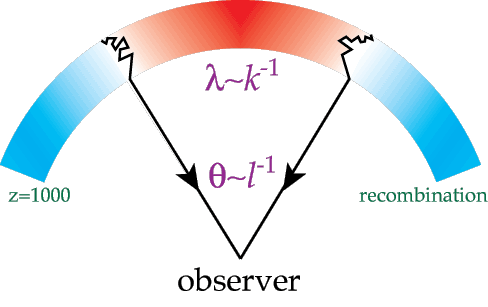
Under the "big bang" model for cosmology, before redshift z=1000, photons in the Cosmic Microwave Background (CMB) were hotter by a factor of (1+z) and hence were able to ionize the hydrogen in the universe. Compton scattering of photons and electrons tightly couples the two species. Meanwhile, electromagnetic interactions couple the electrons and baryons together. The photon-electron-baryon system thus can be thought of as a single tightly coupled fluid, which we call the photon-baryon fluid for short to identify the dominant dynamical components. After the "recombination" epoch at z=1000 when neutral hydrogen forms, CMB photons mainly just stream toward the observer at the present. Hence temperature differences on this surface of last scattering become the anisotropies in the CMB temperature we see today (see Figure above).
We believe that large scale structure in the universe grew out of small perturbations in the early universe through gravitational instability. This implies that the photon-baryon fluid moves in a gravitational potential well before last scattering. For the technically minded, this assumes a Newtonian representation of perturbations or gauge The response of the fluid to the gravitational potential fluctuations allow us to measure the properties of the fluid in an expanding universe known to be filled with dark matter, which allows us to extract basic cosmological parameters, as well as those of the seed perturbations, which can be used to pin down the nature of large scale structure formation in the universe.
To extract this sort of information we must analyze a map of the CMB sky such as that displayed at the top of this page from the original COBE satellite detection in 1992. Basically, we want to take the power spectrum of this primordial noise. Since the fluctuations are on the sky, this amounts to taking an angular decomposition of the fluctuations in multipole space l (proportional to the inverse angle) rather than Fourier space k (where the underlying potential fluctuations live). When we do this with the data available at the present time, we get the angular power spectrum of CMB anisotropies:
which we will use to reject or corroborate models such as the one drawn in above (solid line). In the near future, we expect a vast increase in sky coverage and sensitivity at smaller angular scales (high l) where many of the interesting features in the power spectrum lie, as the last two panels projecting satellite capabilities show.
The purpose of these pages is to review the underlying physical mechanisms behind theoretical predictions of the anisotropy, such as that shown above, to lay the basis for the science that may be extracted from future detections.